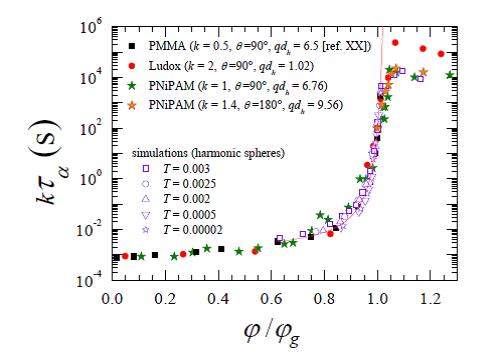Rechercher
Accueil > La Recherche > Axes & Equipes > Matière Molle & Verres > Equipe : Matière Molle > Thème : Jamming, plasticity and material failure
The glass transition of soft colloids
publié le , mis à jour le
The glass transition of soft colloids
People involved : A.-M. Philippe (Postdoc), D. Truzzolillo (CR CNRS), L. Berthier (DR CNRS), L. Cipelletti (Pr).
We use a combination of light and X-ray scattering, rheology, and numerical simulations to investigate the glass transition of soft colloidal particles. In the supercooled regime, the growth of the structural relaxation time with volume fraction is reminiscent of the super-Arrhenius behavior of fragile molecular glass formers, in stark contrast with previous experiments reporting an Arrhenius-like growth, as in strong glass formers. At even higher volume fractions, we unveil a new dynamical regime, where the relaxation time saturates and hardly depends on packing fraction. The onset o this new regime correlates with the decrease of local order in the structure of highly concentrated packings of soft particles. By performing experiments on colloids of different kinds and by simulating particles with widely varying softness, we demonstrate the generality of the scenario presented here.

Universal master curve for the dynamics of soft colloids (structural relaxation time vs volume fraction normalized by the glass transition volume fraction). Solid symbols : experiments ; open symbols : simulations.








